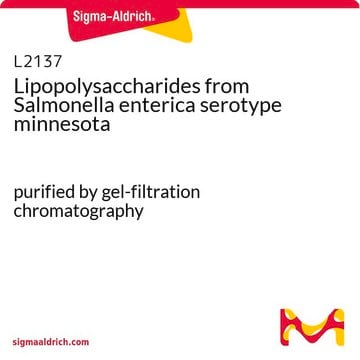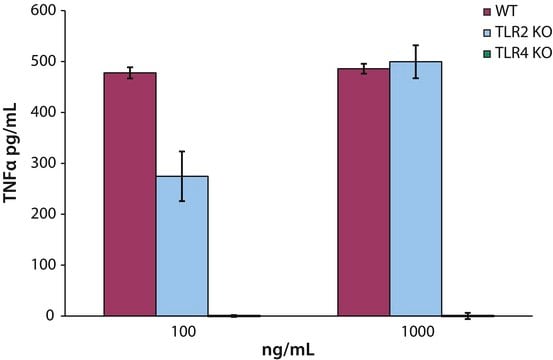L6261
Lipopolysaccharides from Salmonella enterica serotype minnesota
purified by phenol extraction
Sinonimo/i:
LPS
Scegli un formato
Scegli un formato
About This Item
Prodotti consigliati
Origine biologica
Salmonella enterica (serotype minnesota)
Livello qualitativo
Stato
lyophilized powder
Purificato mediante
phenol extraction
Impurezze
<3% Protein (Lowry)
Solubilità
water: soluble
Temperatura di conservazione
2-8°C
Cerchi prodotti simili? Visita Guida al confronto tra prodotti
Descrizione generale
Applicazioni
- as a toll-like receptors (TLR ) agonist to induce tumor necrosis factor (TNF) α production in cereblon[2] and Rabex-5[3] deficient mice in vivo,
- to study its effect on prostaglandin-E Synthase (PTGES) protein expression in monocyte-derived macrophages[4]
- as a positive control for the maturation of monocyte-derived dendritic cells (MoDCs) to assess secretion of interleukin-10 and interferon (IFN)-γ [5]
- as a supplement in Roswell park memorial institute (RPMI)media for culturing splenic B cells [6]
- as a toll-like receptor 4 ligand to study its effect on the expression of the proallergic cytokines thymic stromal lymphopoietin (TSLP) and interleukin 33 (IL33) in H292 cells (pulmonary mucoepidermoid carcinoma cells)[7]
Azioni biochim/fisiol
Altre note
Prodotti correlati
Avvertenze
Danger
Indicazioni di pericolo
Consigli di prudenza
Classi di pericolo
Acute Tox. 2 Oral
Codice della classe di stoccaggio
6.1A - Combustible acute toxic Cat. 1 and 2 / very toxic hazardous materials
Classe di pericolosità dell'acqua (WGK)
WGK 3
Punto d’infiammabilità (°F)
Not applicable
Punto d’infiammabilità (°C)
Not applicable
Scegli una delle versioni più recenti:
Possiedi già questo prodotto?
I documenti relativi ai prodotti acquistati recentemente sono disponibili nell’Archivio dei documenti.
I clienti hanno visto anche
Articoli
Explore the structure, function, and diverse applications of Lipopolysaccharides. Discover their role in bacteria, serological specificity, and research potential.
Filtri attivi
Il team dei nostri ricercatori vanta grande esperienza in tutte le aree della ricerca quali Life Science, scienza dei materiali, sintesi chimica, cromatografia, discipline analitiche, ecc..
Contatta l'Assistenza Tecnica.




